FAST FACTS
Capital: Manila
Population: 118.8 million
Youth population: 19% between 15–24; 30% <14 years old
Median age: 25
GDP: US$471.5 billion (2024)
Currency: Philippine peso (PHP)
Language: Filipino and English
Main language of instruction: English at all levels
English proficiency: “High” (#20 of 113 countries ranked on the EF English Proficiency Index, #2 of 23 Asian countries)
Religion: Predominantly Christian with a small Muslim minority
Geography: The Philippines is composed of more than 7,000 islands in Southeast Asia. Two islands – Luzon and Mindanao – account for two-thirds of the total land area
Key student cities: Quezon, Makati, Manila, Pasig, Cebu, Mandaue, Taguig, Davao City, Caloocan, Zamboanga City (according to ChinaAdmissions.com [ ).
Outbound students: At least 80,000, given 2023/24 data from Canada and Australia alone
Top fields of study for Vietnamese looking at study abroad: Business, health services, hospitality, tourism, engineering, IT-related courses
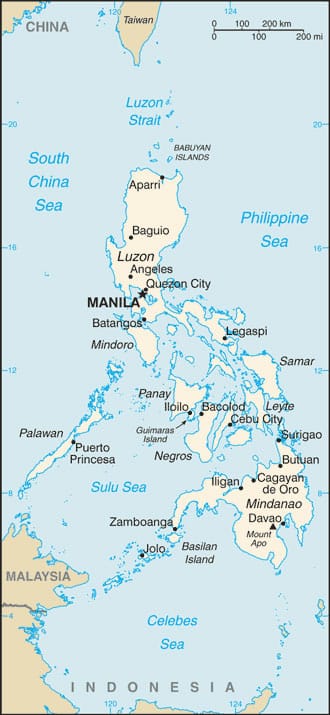
The Philippines has become a top market for many international educators and is sending out more than double the number of students it did a decade ago. Just looking at the growth trajectory of Filipino students in Canada and Australia provides ample evidence of why so many educators are intensifying their recruiting in this Southeast Asian market:
- Australia: 31,760 in 2024, up from 8,492 in 2019 (+274%)
- Canada: 48,870, up from 7,730 in 2019 (+567%)
IDP Country Director Jojo Habana says that other popular destinations for Filipino students are United Kingdom, New Zealand, and Ireland – but even combined, the number of Filipinos in these countries is much smaller than the number in either Canada or Australia. There are under 4,000 Filipino students in the US, and under 4,000 in New Zealand and Ireland.
What has drawn so many Filipino students to Australia and Canada?
The Philippines is what is often termed as a “migratory” market – i.e., the largest segment of students are interested in emigrating and creating new lives with their families in host countries. Filipinos, like Indonesians, consider family connections incredibly important when assessing study abroad options. IDP Education Philippines sales and operations head Maria Cecilia Mundo has noted:
“We know that all students who study internationally, it’s all about helping their families, helping their economy, increase their means of living, support their siblings and relatives.”
There are several important implications of this migratory drive and associated priority of bringing family members:
(1) Despite the relatively low median age in the Philippines (25 years of age, the lowest in Asia outside of Pakistan), the average age of prospective Filipino students is relatively high. For example, ApplyBoard reports that “the average age of Filipino students applying to study in Canada on [its] platform was 31 in 2022.” At this age, many Filipinos are parents – and thus naturally interested in bringing their family with them when they study.
(2) Adult Filipino students’ interest in bringing their family abroad is reflected in ApplyBoard’s report that in 2022, there was a 126% increase in secondary (school) approvals and a 120% increase in primary (school) approvals for Filipino students coming to Canada. As shown in the chart below, the K-12 sector has experienced the most growth from incoming Filipinos, followed by the college sector. This is largely a function of adult Filipino students coming to Canada for college studies and bringing their children to study in Canadian K-12 schools.
(3) Mature Filipino students often have tertiary qualifications from Filipino universities, which is driving interest in postgraduate programmes. ChinaAdmissions.com notes that the surge in Filipino students abroad is largely accounted for by those in postgraduate programmes. In the US, there only slightly fewer Filipino graduate students than undergraduate students.
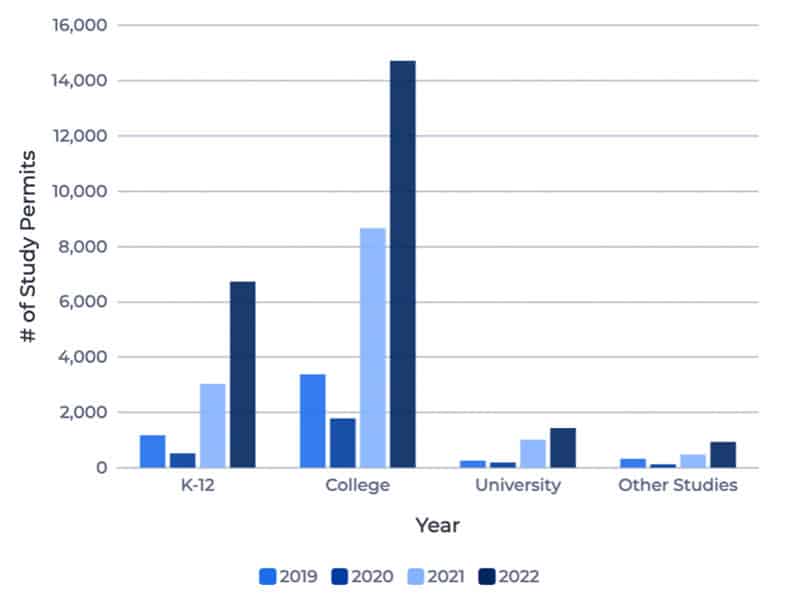
Room for more competition
For the past few years, the overwhelming preference of Filipino students considering study abroad has been to study in Canada or Australia. The US International Trade Administration notes that “U.S. schools should be prepared to invest considerable time and financial resources into the Philippine market as competition is fierce.” However, recent policy changes in Australia and Canada – as well as the UK – will almost provide more room for institutions from other countries to compete for Filipino students.
Specifically:
Canada: In 2024, the spouses of international students who are in undergraduate or college programmes are no longer eligible for open work permits. Only those in master’s or doctoral programmes, or in professional programmes such as medicine and law, are eligible for open work permits. Given the tendency of Filipino students to bring their family with them, this will have a significant effect on demand from the Philippines for Canadian undergraduate and college programmes.
In addition, Canada has raised the level of available funds required for each study permit applicant to CDN$20,635 (US$15,040) – plus the first year of tuition and additional proof of being able to cover other costs. The requirement increases with every additional family member the student brings with them:
Number of applicants (including the student) in CDN dollars
1: $20,635
2: $25,690
3: $31,583
4: $38,346
5: $43,392
6: $43,051
7: $54,611
Given that the average income in the Philippines is under CDN$14,000 (US$10,000), the new funds requirement will be steep for many prospective international students – especially if accompanying spouses can’t get a work permit.
Australia: In Australia, the new “Genuine Student Test” – and an alleged degree of subjectivity being applied by immigration officials to visa applications – is resulting in skyrocketing visa rejection rates, especially for Southeast Asian applications. In addition, Australia has raised its available funds threshold to AUD$24,505 (US$15,690) per student. If that student applies to bring their partner, it is an additional AUD$8,574 and per child, it is an additional AUD$3,670. The alternative is being able to show annual income of AUD$62,222 per student or AUD$72,592 for families. The spouses of international students are only able to work part-time.
United Kingdom: In 2024, the majority of international students are no longer permitted to bring family members with them while they study. The exception is those pursuing research postgraduate degrees. In addition, the funds threshold for those wanting to work in the UK on a Skilled Worker visa has been raised to £38,700. Those applying for a family visa will now need a salary level of £38,700.
Clearly, many institutions in Canada, Australia, and the UK could find it more difficult to recruit Filipino students – especially those at the undergraduate level – under current government policies. Scholarships and/or other student supports will be an important lever for those institutions able to offer them in this market.
Important facts to know about the Filipino market
(1) Cost of living concerns on the rise: Despite strong demand for study abroad, an IDP Emerging Futures survey in 2023 found that 68% of Filipino respondents said they were reconsidering their plan to study abroad, citing increased cost of living. The Philippines has been one of the fastest-growing Asian economies in recent years, but in 2023, rising inflation and interest rate hikes put downward pressure on household spending. The economy expanded by 5.6% in 2023, short of a government target of 6-7%. Still, as shown in the chart below, the Philippines economy remains been a rising star in Asia.
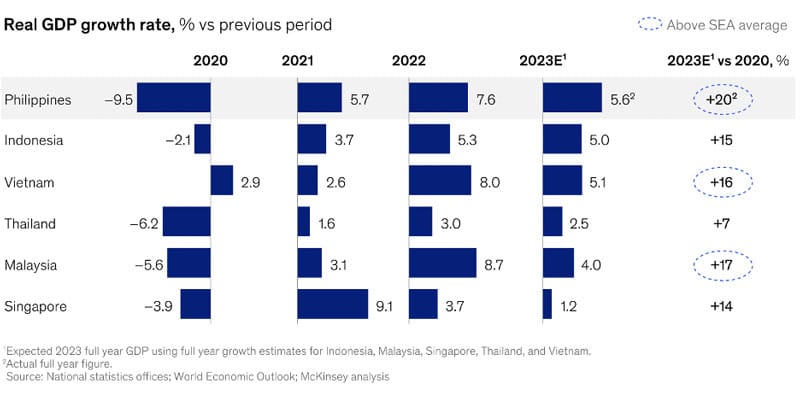
(2) Social media strategies are key to reaching students in this market: Filipinos are among the most active nationalities in the world on social media, spending an average of 10 hours a day, seven days a week on various platforms. The top platforms (in terms of active monthly users) are Facebook (95%), Facebook Messenger (92%), TikTok (80%), and Instagram (75%). ChinaAdmissions.com also notes that “LinkedIn’s usage (has also been growing among newly graduated students and young professionals.”
(3) English-taught programmes are preferred: The Philippines’ official languages are English and Filipino, but the language of instruction at all levels of study is English. This makes Filipino students particularly well suited for direct entry into university programmes.
(4) The ability to work is highly important: A 2023 IDP survey found that 87% of Filipino respondents said they hoped to fund their study abroad experiences at least partly through part-time work. Most intended to apply for a post study work visa after completing their studies.
(5) International schools: There are many good international schools in the Philippines, especially in Manila, Cebu, and Davao. They tend to follow a US curriculum model and many offer the IB and Advanced Placement programmes. Typical tuition is US$13,000–$20,000 per year. The US Trade Administration identifies these schools as some of the best in Manila: Brent International School, British School of Manila, Chinese International School Manila, Domuschola International School, International School of Manila, The King’s School Manila, Multiple Intelligence International School, Reedley International School, Korean International School Philippines, The Beacon School, Faith Academy, Australian International School, and Southville International School and Colleges.
(6) Solid higher education institutions: At the tertiary level, most institutions (90%) are private but public institutions enrol about a third of all students. Public higher education is free. The higher education supervisory body, the Commission on Higher Education (CHED), provides a list of all tertiary-level, degree-granting institutions in both the private and public sectors. Five Filipino universities are ranked in QS’s World University Rankings, and all have improved their rankings:
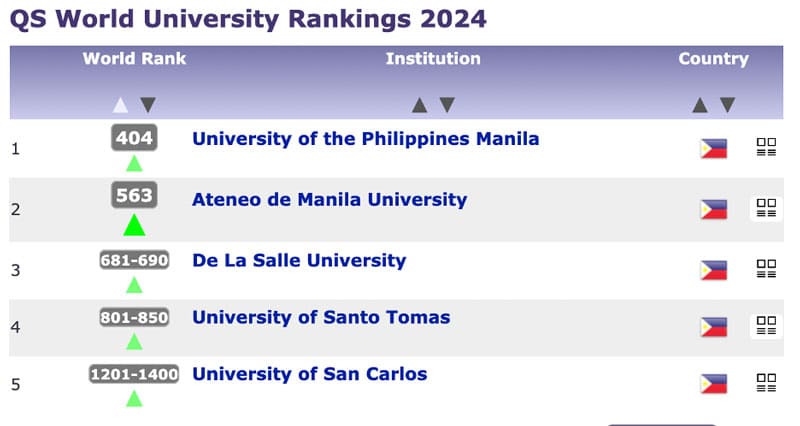
These universities also have important subject strengths. For example:
- Ateneo de Manila University, University of the Philippines Manila, and De la Salle University are in QS’s Top 500 for Arts & Humanities (2024).
- University of the Philippines Manila is in the 501-550 ranking for Engineering & Technology and 401-450 for Life Sciences & Medicine.
- Ateneo de Manila University, University of the Philippines Manila, and De la Salle University are in the top 500 for Social Sciences & Management.
(7) Scholarships: We expect to see more scholarships offered to Filipino students this year as the competition intensifies in this market and as government policy changes affect both Filipinos’ ability to fund their studies and their demand for different destinations.
(8) Family ties mean a lot: There are large Filipino diasporas in several countries including Canada and Australia, and this represents a competitive advantage. Filipino students consider the presence of family of friends in their decision-making, and they often receive financial support from them while studying. Institutions should also take care to tailor some of their communications and outreach to Filipino parents. Profiling successful Filipino alumni and allowing prospective students to chat with current Filipino students are excellent strategies, as is a dedicated website page for Filipino students, as per the example below from Nottingham Trent University.
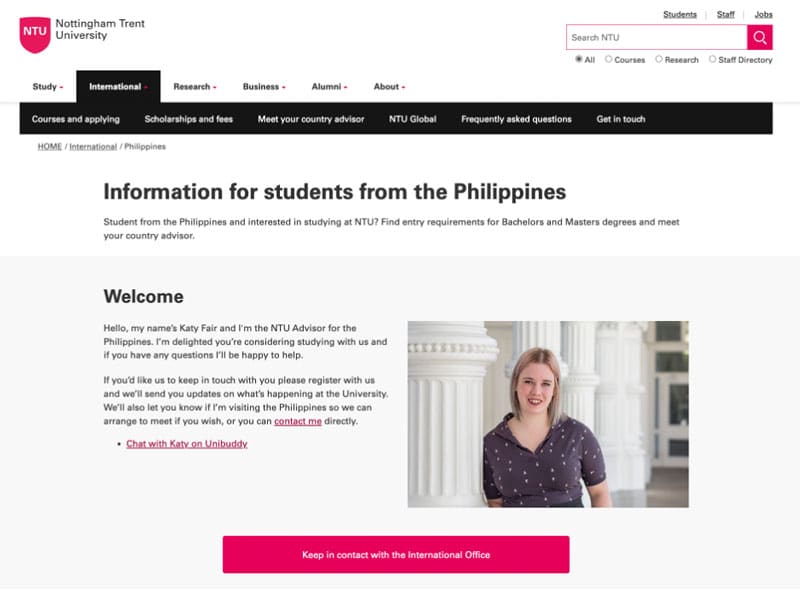
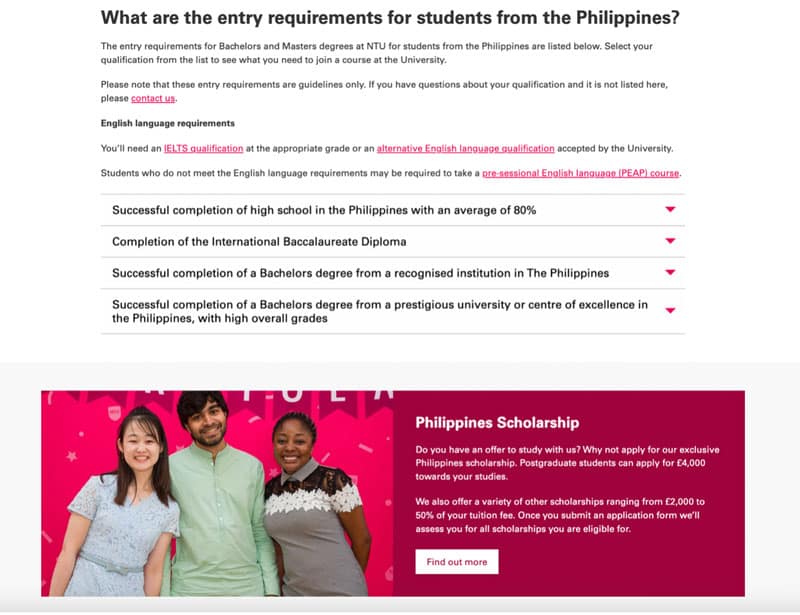
For additional information, please see:
Source